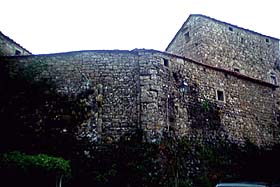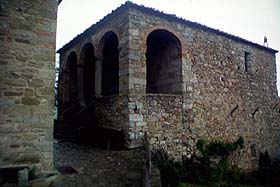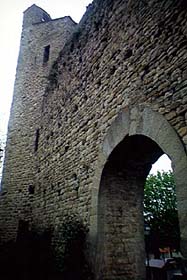Castle of Montemignaio
 |
 |
| The keep polls from the boundaries of the palace. |
The primitive chapel of the castle. |
Montemignaio can be reached from Florence following the indications for Pontassieve,
from here continuing toward the Consuma Pass on the the SS70 Umbro-Casentinese.
Crossed the pass there are the indications that conduct at the castle (SP71)
.
 |
| The Gate with the bell tower. |
The origin of the castle of Montemignaio is to seek from the passage in the
zone of the ancient Roman road that, from Florence, through Pelago and the Crocevecchia
Pass, forwarding in the southern slope of the mountains of Consuma and Secchieta,
joined the principal artery of the antiquity that, passing the Casentino valley
conducted to Arezzo. The ancient road was still used during the Middle Ages
and this led to the development of the castle in a dominant position at the
vertex of a hill on precipice overlooking the valley of the stream Fiana.
The first document confirming the existence of the settlement goes back to
the year 1103, it was a papal bull which was confirmed to the Bishop of Fiesole
the authority on the Parish of Montemignaio. Already in the following years
and for the whole 12th century the area was remembered belonged to the dominions
of the Guidi counts, in consequence was the investiture of the feudal count
Guido Guidi in the nearby castle of Poppi, a privilege
also confirmed by a document of the 1191 signed by the emperor Arrigo IV. Were
the Guidi to erect here the castle known as 'Castel Leone' or simply 'Castiglione',
which remained in the possession of the noble family up to the revolt of Castel
S.Niccolò, with whose inhabitants the Montemignanesi made common cause against
the abuse of power of the last descendant of the feudal family, the count Galeoto.
In 1440 the same inhabitants were conquered by the Commune of Florence and Montemignaio
was admitted to the 'Potesteria of the Florentine Mountain'. The remains of
the castle still dominate the country. To the right of the main gate still rises
a mighty tower that also acted as bell tower, to the left a second one, probably
a twin of the other, is today notably reduced in height. The two towers are
united by the mighty walled curtain in which the beautiful gate is opened, with
its Roman arch, that introduces the heart of the castle. Upon entering we find
on the left the ruins of the palace, first the residence of the counts and of
then the Florentine Podestà. We also see the square Keep. In the walls it is
still possible to note the walled form of a gate that once led into the inner
court of the Palagio. Today to access the splendid courtyard, endowed with a
beautiful well in the center, it is necessary to make the outer turn of the
walls from the right of the outside gate. Immediately behind the massive structure
of the keep rises the primitive chapel of the castle. The complex, rather well
kept, it is one of the best examples of Tuscan medieval strengthened suburb
of mountain.
|


